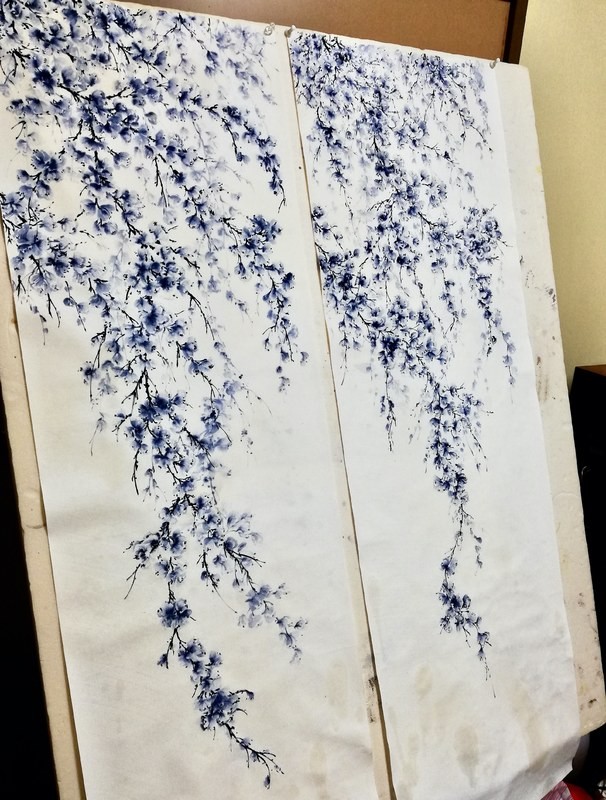12 April, Hiromasa Togami
文字数 3,579文字
“When you get older, you come to truly appreciate the arrival of spring, and what it means to see the cherry blossoms. Someday, you’ll understand.”
As my mother spoke, her back turned my way in divided attention, I impassively noted the outline of her diminutive frame, vaguely registering the statement only in passing. Yet now, for some reason, the spring
As a young artist in my twenties, the
Analysis superseded by pensive reflection, I no longer scrutinize each individual petal, but rather, am free to pause, lingering beneath the boughs. I no longer reach for my sketchpad to record the shape of each delicate blossom, or fastidiously note the way the heavy branches sway gently, buoyed by the breeze. I simply observe, from a distance.
Now, the
This retinue of disparate experiences, accumulated over the span of a lifetime, is resurrected from where it lay dormant, buried deep in my breast, bursting into bloom alongside the
Beneath the cherry tree, I was overcome with that peculiar sensation felt when one ending dovetails neatly into a new beginning. Although it’s difficult to articulate in words, there’s something sublimely pure in this sensation, as if providing a palpable affirmation that yes, I am alive, here in the present.
As the cherry blossoms sway in the wind, I feel that I now understand.
Perhaps this was what my mother meant by the spring
Taking stock of the gentle spring breeze and infinite tiny blossoms foregrounded against a pale blue sky, I see the innumerable events leading up to this moment, and realize that perhaps the
Of course, this year is unlike the last. It’s no longer possible to view the
Even the faint outline of the cherry tree seen off in the distance through my dusty window invites reflection on a spring day.
Such reminiscence reminds me that I, too, am a part of nature and the changing seasons. The cycle continues, and spring has returned.
On this day, I discover in myself a newfound gratitude for the passage of time and the very virtue of being alive—a gratitude too profound even for words.

Translated by Daniel González/Arranged by TranNet KK
Hiromasa Togami
Born in Fukuoka Prefecture, 1984. Suiboku-ga (ink wash) painter. Made his literary debut with
As my mother spoke, her back turned my way in divided attention, I impassively noted the outline of her diminutive frame, vaguely registering the statement only in passing. Yet now, for some reason, the spring
sakura
never fail to transport me back to this banal familial scene.As a young artist in my twenties, the
sakura
were nothing more than another classical motif to be mastered on the road to becoming a real painter. Many years later, my twenties long behind me, now that I have learned how to paint thesakura
by rote and lost all painterly passion for the subject, I find that I have, conversely, at last come to truly appreciate the cherry blossoms.Analysis superseded by pensive reflection, I no longer scrutinize each individual petal, but rather, am free to pause, lingering beneath the boughs. I no longer reach for my sketchpad to record the shape of each delicate blossom, or fastidiously note the way the heavy branches sway gently, buoyed by the breeze. I simply observe, from a distance.
Now, the
sakura
elicit a wellspring of emotion, a cascading reminder of former passions and countless hours spent painting countless blossoms—all those moments, snapshots in time, on parade.This retinue of disparate experiences, accumulated over the span of a lifetime, is resurrected from where it lay dormant, buried deep in my breast, bursting into bloom alongside the
sakura
. How strange, then, to realize that these cherry blossoms I see have flowered in the newest threshold of my life.Beneath the cherry tree, I was overcome with that peculiar sensation felt when one ending dovetails neatly into a new beginning. Although it’s difficult to articulate in words, there’s something sublimely pure in this sensation, as if providing a palpable affirmation that yes, I am alive, here in the present.
As the cherry blossoms sway in the wind, I feel that I now understand.
Perhaps this was what my mother meant by the spring
sakura
. Perhaps by “appreciation,” she meant the recognition of such moments, when the full breadth of one’s life unfolds in a brilliant, fleeting instant, giving form to the otherwise unquantifiable accumulation of experience.Taking stock of the gentle spring breeze and infinite tiny blossoms foregrounded against a pale blue sky, I see the innumerable events leading up to this moment, and realize that perhaps the
sakura
impress a deeper meaning beyond the mere sum of their petals alone.Of course, this year is unlike the last. It’s no longer possible to view the
sakura
in quite the same way as before. And yet, spring has come, reliably conjuring up the same reveries as always.Even the faint outline of the cherry tree seen off in the distance through my dusty window invites reflection on a spring day.
Such reminiscence reminds me that I, too, am a part of nature and the changing seasons. The cycle continues, and spring has returned.
On this day, I discover in myself a newfound gratitude for the passage of time and the very virtue of being alive—a gratitude too profound even for words.

Translated by Daniel González/Arranged by TranNet KK
Hiromasa Togami
Born in Fukuoka Prefecture, 1984. Suiboku-ga (ink wash) painter. Made his literary debut with
Sen
wa
,boku
o
egaku
(The line draws me), for which he won the 59th Mephisto Prize.


